What Would Zappos Do?
[This article was originally published on the Fractured Atlas blog, January 6, 2015]
This past holiday season I found myself increasingly asking the question — WWZD? What Would Zappos Do?
- Why is the venue usher being so unreasonable to that couple and ruining the concert for everyone? WWZD?
- Why does it seem like that ticket agent is auditioning for the role of The Grinch? WWZD?
- Why is that person yelling at customers to separate into multiple lines when there is no signage indicating that that’s what the store prefers? WWZD?
For years I have been somewhat of a Zappophile, if you will, studying the ways of this company that has come to represent the gold standard in customer service. Staying on the phone with a customer for eight hours to resolve her issues, and that’s not frowned upon? Zappos. Creating a workplace that’s fun and a little weird? Zappos. Delivering WOW while buying shoes? Zappos.
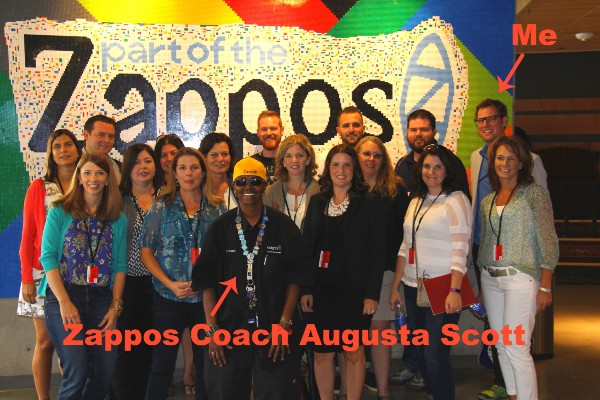
While I can only hypothesize WWZD in the above situations that I’ve experienced in recent weeks, earlier this Fall I had the great fortune to visit Zappos’s headquarters in Las Vegas to see firsthand WDZD — What Does Zappos Do. (Thank you to my gracious hosts: the Zappos Insights team and Zappos Coach Augusta Scott.)
Below are some of the most memorable moments from my visit to Zappos:
(1) Zapponians talk constantly about their ten core values. I mean, constantly. And it’s not in the contrived way we see on The Office or in Office Space. This is in an everyone has them tattooed on their soul type of way.
Everyone is referencing and reinforcing the company’s values all. the. time. I’m not exaggerating when I say that. About half of what came out of people’s mouths during my stay was related to their core values in one way or another. It’s not in a generic, corporate way of “Remember Our Core Values” signs and banners, it’s more in a “Oh yeah, we did that because of core value number 3.” Everything is about how a decision was based on core value #1, or how someone is working on improving their performance on core value #5, or how you can use your voice to convey core value #8 while on the phone.
During their quarterly all hands meeting of the 1,600 staff they screened a scene from Divergent that their video team edited to make it about Zappos’s core values. That same meeting ended with a Zappos rock band and choir performing an original song about their core values as the audience of employees rocked out.
Imagine how your organization would be different if your core values were so ingrained in your people as to be second nature. Would decisions be made differently? Would your staffing decisions change? Would your programs and services reflect this?
(2) Everyone has exactly the same size desk.
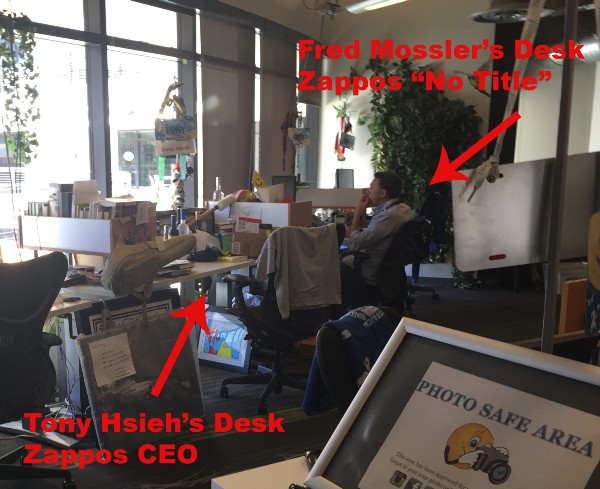
This one made a particular impression on me since we’re undergoing a renovation to make room for more desks in the Fractured Atlas office. In the Zappos office, every person has exactly the same size workstation in an open bullpen format — from CEO Tony Hsieh to the customer loyalty team member who started working yesterday. Same workstation. Need a little privacy? Move to one of the lounge spaces or check out one of the many small conference rooms around the building.
Tony explains in this article on Inc.com why Zappos designed its space to maximize serendipity and meaningful collisions.
Research shows that by breaking down the walls and putting your team in close proximity you set the table for greater collaboration and innovation. Maybe the new model we’ve been looking for in the arts is solved with desk size and working proximity?
(3) Holiday Helpers. All Zappos employees go through the same four-week training program before transitioning into the job they were hired to perform. Call Zappos with a question and you might just speak with their new head of finance, or general counsel, as they complete the required customer service training too.
Think about it. You went through an exhaustive search to identify and hire your new Director of Development. You anxiously await her arrival and then you need to wait another month before she finishes her “core curriculum” training. That’s the cost of doing business when you want everyone in your organization to be able to deliver the same high level of customer service regardless of their position. (They also famously offer new hires $2,000 to leave after the second week to weed out those who aren’t a good fit for the organization.)
This early training is not simply a rite of passage, it’s laying the groundwork for their Holiday Helpers initiative. Not surprisingly, the holiday season is Zappos’s busiest time of the year. In addition to hiring temporary staff to help with the extra work, every staff member from CEO Tony Hsieh on down are required to spend 10 hours on the phones between Thanksgiving and New Year’s chipping in on the customer service front.
How would arts organizations operate differently if the Executive Director made a habit of working in the box office, showing guests to their seats for a performance, or serving coffee at the concession stand during halftimeintermission?
(4) Quarterly all hands meetings are primarily about the “soft stuff.”
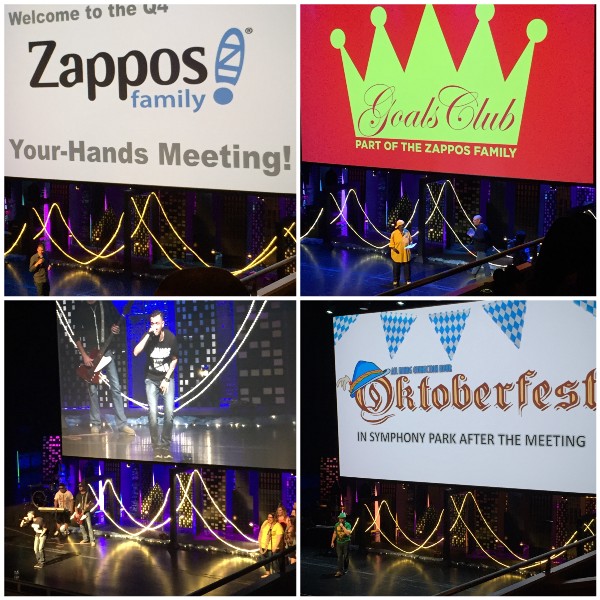
One of the highlights of my time at Zappos was being able to attend their quarterly all hands meeting. They held the meeting at The Smith Center (home of the Las Vegas Symphony), turned on their voicemail — seriously, if you tried calling Zappos during this meeting you would have heard a voicemail greeting saying no one was home — and all attended the 3+ hour meeting followed by an Oktoberfest happy hour (Zappos core value #3: Create Fun and A Little Weirdness).
These all hands meetings spend a huge amount of time on the “soft” stuff. Sure there was some talk about this policy change or that press announcement, but the better part of that meeting was spent talking about, and recognizing Zapponians for, their accomplishments. This included people who worked with coach Augusta Scott to complete the 30-day goals program, to their Movember Team, extreme athletes, and the Zappos choir.
During the all hands meeting, I wondered what would happen if a symphony orchestra secretly replaced their concert ushers with Zappos customer loyalty team members. Now, I’ve never attended a performance at The Smith Center, so for all I know the ushers are already on par with Zappos CLT members. However, I’m speaking in more generic terms about what if any hall secretly replaced its ushers for a performance (especially the place I visited recently where the ushers were not interested in delivering WOW through service (Zappos core value #1)). Would this noticeably change the arts-going experience? Make it more fun and entertaining?
(5) Geo-tagging and personal connections.
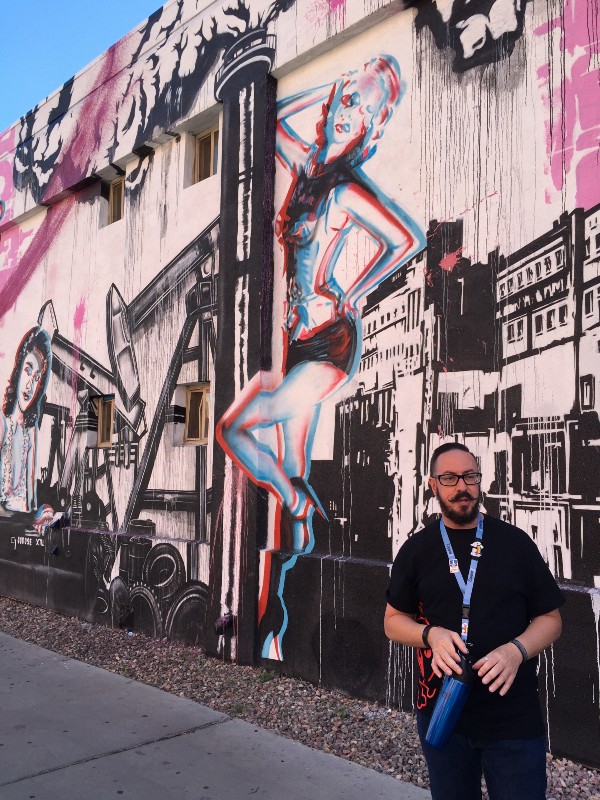
On our tour of the customer loyalty group bullpen, I learned how Zappos’s phone system routes customer calls to CLT members who have a higher probability that at some point they lived near the caller. This helps create the personal connections CLT members look to establish during their interaction. Our tour guide recalled fielding a call from a women who lived a block away from his childhood home. Think of the personal bond that that customer now feels with Zappos because of the personal interaction and vice versa.
How would the arts-going experience be different if instead of policing the audience, house staff tried to make two personal connections with audience members. “I love your scarf!” “You’re rocking a great pair of shoes!” “I’m so happy you’re joining us today, this performance is mind-blowing!” (It sure beats, here’s your program, there’s seat G15.)
(6) Lots of talk about holacracy.
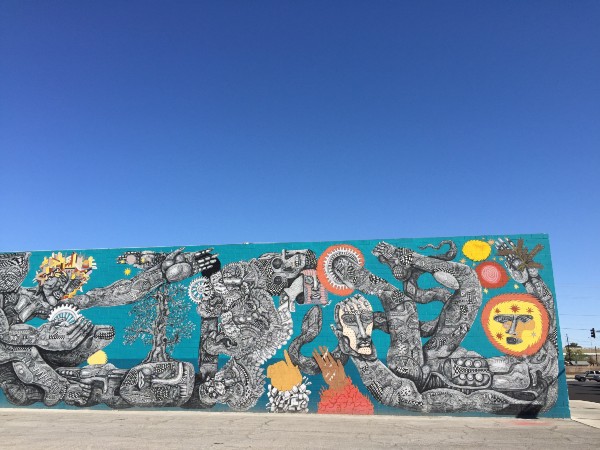
It’s huge, it’s messy, it’s confusing, it’s stressful, but it’s worth watching this experiment to see how it plays out when a successful, fast-growing company essentially throws all of the pieces up in the air and attempts to have them fall in a configuration free of traditional hierarchy and titles. This experiment is partly aimed at re-injecting the feeling they had in the early days of limitless innovation and entrepreneurship into what has grown to become a 1,600-person company.
While on the surface people put on a brave face, if you scratch just a bit I got the sense that there’s a great deal of anxiety associated with this change. I also got the sense that some people thought Zappos was undertaking this due to restless entrepreneurs at the helm. Either way, they’re doing it and we should watch closely to see what happens. (Zappos core value #2: Embrace and Drive Change; and #4: Be Adventurous, Creative, and Open-Minded)
Is your organization designed to be entrepreneurial and support a culture of innovation? Do you have a way for people to make small bets, some of which evolve into new programs and services?
(7) I never heard Zapponians say anything about Zappos selling shoes. This was a bit of a shock to me, and I only realized it while riding the shuttle back to the airport. If I hadn’t known what Zappos did, I likely would have thought this company was a design firm or software company.
My sense is that they could choose to do any one of 1,000 things, and with their strong culture and commitment to stellar service they would still be successful.
What’s the cultural sector’s equivalent of not talking about shoes? Should we stop talking about art? What would we talk about instead? How might an arts organization reframe its collective purpose in such a way that the art itself is just a semi-arbitrary means to an end?
(8) Coach your people to success. Recently, I saw this cartoon with two managers discussing investing in employee development. In it, the first manager says, “What if we train them and they leave us?” To which the second replied, “What if we don’t … and they stay?”
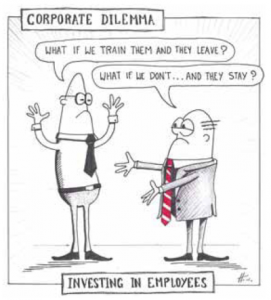
Zappos cares about developing its people. They show this in many ways, one of which is employing a full-time personal coach. Coach Augusta Scott works with a handful of Zapponians each month as they make progress towards achieving a variety of goals. Some people come to her wanting to buy a house, or passing the CPA exam, or losing weight (Augusta prefers to say you’re releasingweight because you often find those things you lose).
It’s not possible for most of our organizations to employ a personal coach. We can however do things that move things forward on this front. Maybe organize a monthly wellness challenge? (Post a tote board in the office this February to count the number of times people walk up the stairs.) Maybe a monthly book club of people trying to accomplish a specific goal? (I recommend reading Get Off Your But by Sean Stephenson, The Happiness Project by Gretchen Rubin, or the newly published Game Plan by my friend Ciara Pressler to kick off 2015 and support your New Year’s resolutions.)
(9) Zappos really is a special place.
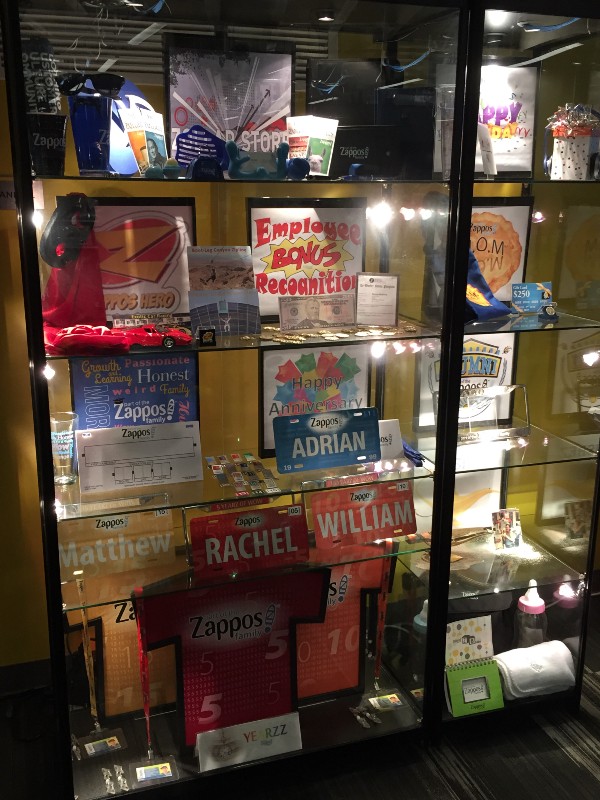
Every single person I met during my time at Zappos was kind and friendly and helpful, and was positive about their coworkers and the organization. (Zappos core value #7: Build a Positive Team and Family Spirit.)
I can hear readers saying, this is all well and good, but it’s Zappos. They have tons of money to do things like this. How am I supposed to do any of this with a nonprofit budget? I hear you, but read Tony Hseih’s Delivering Happiness to learn about how Zappos nearly went out of business several times before they became the Zappos we know today. A culture of innovation and excellence with strong core values doesn’t emerge fully formed overnight.
Zappos found the secret, and I think the WWZD frame is a helpful one to apply when thinking about better ways of accomplishing something that doesn’t quite seem to work — What Would Zappos Do?
About Tim Cynova
Tim wears a multitude of hats, all in service of creating anti-racist workplaces where people can thrive. He currently is co-CEO of Fractured Atlas (an entirely virtual organization with staff spread across multiple states and countries) and a Principal of the consulting group Work. Shouldn't. Suck. He serves on the faculty of Banff Centre for Arts & Creativity and The New School teaching courses in People-Centric Organizational Design; he's a trained mediator, and a certified Senior Professional in Human Resources (SPHR). Earlier in his career, Tim was the Executive Director of The Parsons Dance Company and of High 5 Tickets to the Arts in New York City, had a memorable stint with the Cincinnati Symphony Orchestra, was a one-time classical trombonist, musicologist, and for five years in his youth he delivered newspapers for the Evansville, Indiana Courier-Press. Also, during a particularly slow summer, he bicycled 3,902 miles across the United States.


